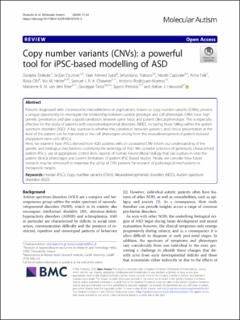| dc.contributor.author | Drakulic, Danijela | |
| dc.contributor.author | Djurovic, Srdjan | |
| dc.contributor.author | Syed, Yasir Ahmed | |
| dc.contributor.author | Trattaro, Sebastiano | |
| dc.contributor.author | Caporale, Nicolò | |
| dc.contributor.author | Falk, Anna | |
| dc.contributor.author | Ofir, Rivka | |
| dc.contributor.author | Heine, Vivi M. | |
| dc.contributor.author | Chawner, Samuel J.R.A. | |
| dc.contributor.author | Rodriguez-Moreno, Antonio | |
| dc.contributor.author | van den Bree, Marianne B.M. | |
| dc.contributor.author | Testa, Giuseppe | |
| dc.contributor.author | Petrakis, Spyros | |
| dc.contributor.author | Harwood, Adrian J. | |
| dc.date.accessioned | 2021-06-28T07:43:21Z | |
| dc.date.available | 2021-06-28T07:43:21Z | |
| dc.date.created | 2020-08-11T12:26:22Z | |
| dc.date.issued | 2020 | |
| dc.identifier.issn | 2040-2392 | |
| dc.identifier.uri | https://hdl.handle.net/11250/2761493 | |
| dc.description.abstract | Patients diagnosed with chromosome microdeletions or duplications, known as copy number variants (CNVs), present a unique opportunity to investigate the relationship between patient genotype and cell phenotype. CNVs have high genetic penetrance and give a good correlation between gene locus and patient clinical phenotype. This is especially effective for the study of patients with neurodevelopmental disorders (NDD), including those falling within the autism spectrum disorders (ASD). A key question is whether this correlation between genetics and clinical presentation at the level of the patient can be translated to the cell phenotypes arising from the neurodevelopment of patient induced pluripotent stem cells (iPSCs).
Here, we examine how iPSCs derived from ASD patients with an associated CNV inform our understanding of the genetic and biological mechanisms underlying the aetiology of ASD. We consider selection of genetically characterised patient iPSCs; use of appropriate control lines; aspects of human neurocellular biology that can capture in vitro the patient clinical phenotype; and current limitations of patient iPSC-based studies. Finally, we consider how future research may be enhanced to maximise the utility of CNV patients for research of pathological mechanisms or therapeutic targets. | en_US |
| dc.language.iso | eng | en_US |
| dc.publisher | BMC | en_US |
| dc.rights | Navngivelse 4.0 Internasjonal | * |
| dc.rights.uri | http://creativecommons.org/licenses/by/4.0/deed.no | * |
| dc.title | Copy number variants (CNVs): a powerful tool for iPSC-based modelling of ASD | en_US |
| dc.type | Journal article | en_US |
| dc.type | Peer reviewed | en_US |
| dc.description.version | publishedVersion | en_US |
| dc.rights.holder | Copyright The Author(s). 2020 | en_US |
| dc.source.articlenumber | 42 | en_US |
| cristin.ispublished | true | |
| cristin.fulltext | original | |
| cristin.qualitycode | 1 | |
| dc.identifier.doi | 10.1186/s13229-020-00343-4 | |
| dc.identifier.cristin | 1822725 | |
| dc.source.journal | Molecular Autism | en_US |
| dc.relation.project | Helse Sør-Øst RHF: 2018094 | en_US |
| dc.relation.project | COST (European Cooperation in Science and Technology): CA16210 | en_US |
| dc.identifier.citation | Molecular Autism. 2020, 11, 42. | en_US |
| dc.source.volume | 11 | en_US |

